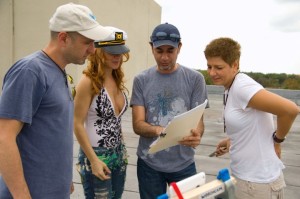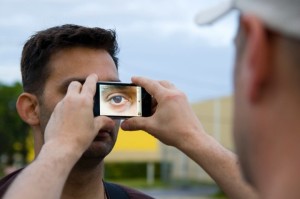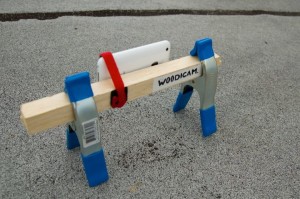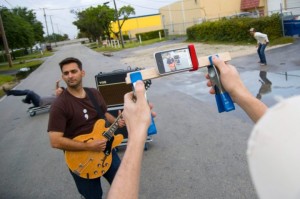To be memorable—and worth repeated views—a music video should combine a strong musical performance with original moviemaking. A good example is Ricardo Bigai’s E.M.O., a multiscreen music video, which won 2nd place at the Original iPhone Film Festival.
E.M.O. isn’t the first mobile multiscreen music video. But it definitely pushes the boundary leading to the (spoiler alert) marvelous composite face near the end. In the following interview, Ricardo let’s us in on some of his secrets.
MMM: How did you get into filmmaking?
Ricardo: I love movies, and I love them in a technical way. But the funny thing is that I’m not into video or filmmaking. I’m a Sound Engineer and Musician. But because most of my career as a Sound Engineer has been in post-production, I’ve been working in post houses. This has given me a good notion on video making. I know Final Cut, and even at some point (long time ago) I worked as linear editor (Betacams and a Switcher). but I’m an audio guy.
MMM: What is your relationship to the band?
Ricardo: I’m the bass player. and I did all the audio engineering of our albums.
MMM: How did you come up with the concept of using smartphones as screens for the video?
Ricardo: The classic “what if”occurred to me: What would happen if some friends had their iPhones on a table? I actually did a very basic experiment of running people from one iPhone to another at that very moment. More complex ideas came after. Although we didn’t have any budget, I dared to do it.
MMM: How did you plan the video?
Ricardo: Storyboarding. It took me 3 days. I drew it myself. I did the main storyboard, and from there I did one for each screen. We used the storyboards throughout the shooting.
MMM: What devices did you use?
Ricardo: The movie playing on each iPhone was filmed with an iPhone3.
MMM: What about the footage showing the hand manipulating the iPhones?
Ricardo: That material—which we called “the main scene”—was filmed with a Panasonic. You can see the set up in the shot below with the results displayed on a monitor.
MMM: Why did you use a mobile to shoot the videos?
Ricardo: I just liked the idea of doing it with iPhones, and I found out that the iPhone 3 camera was very “forgiving” with us. We looked OK 🙂 Also, we were able to create our own steadicam-like device, which we called the “woodicam.”
MMM: During the production, did you encounter any unexpected problem?
Ricardo: Actually it was an expected problem: to synchronize the five iPhones since all the action occurred in one scene. We borrowed them from friends, so we had various iPhone 3s and one iPod. I knew the response would be different for each one after hitting play, so I put a loud (and bright) pop at the beginning of each video. This way I’d know from the beginning if they were in sync instead of having to wait to the middle of the song. We had to learn a sequence of how to trigger each video. It took a lot practice, but once we heard those five beeps sounding like one, we knew we could move on with the shooting.
I knew the response would be different for each one after hitting play, so I put a loud (and bright) pop at the beginning of each video. This way I’d know from the beginning if they were in sync instead of having to wait to the middle of the song. We had to learn a sequence of how to trigger each video. It took a lot practice, but once we heard those five beeps sounding like one, we knew we could move on with the shooting.
MMM: It sounds complicated.
Ricardo: Well, I think the secret was how well structured was the storyboard. As I told you before I did the main scene’s storyboard, hands choreography included, and each iPhones story. I did a playback track with my voice counting on every single bar, on the storyboard I had the cues over each bar, so for example I knew that on bar 36 the singer had to go out of camera to the right, then on that same bar 36 in a different location the singer would jump in from the left side, and so on.
MMM: How long did the shoot take?
Ricardo: Only 7 hours to shoot the 5 movies! I edited each video in Pro Tools, since it was only cuts, and quality was not an issue since each movie was played on the iPhones, (and I’m very fast with Pro Tools). I checked the flow and sync of the 5 videos with Quicktime Pro, placing the videos in their position on my desktop, and playing all movies at the same time, and moving them with the mouse like they were meant to be moved on the main scene. For the iPhones filming I wanted the girl to be the one moving the iPhones, but I realized it was a very complicated choreography and I did it myself. That scene is a one shot scene. Each iPhone movie had cuts. Most of the hands movements were meant to hide them.
MMM: Amazing.
Ricardo: We got what we wanted on the 51st take!
MMM: Can you tell us something about your crew?
Ricardo: I was very lucky to work with very professional friends, Rafael Mata did the photography, Alejandra Romero and Marlene Mata from The Gatos Media did the production, and Albert Fortgang did the conforming.
MMM: If you make another movie, we’ll look forward to seeing it.
* * *
You can find the band’s music at https://itun.es/us/DV2bt






 Previous post
Previous post
 Next post
Next post





